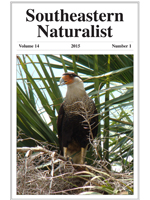Native earthworms were removed from forested ecosystems during the last glacial advance and have since been replaced with nonnative earthworm species. Nonnative earthworms can cause major changes in microbial and plant communities and nutrient cycling. In this study, we sought to compare the earthworm communities north and south of the last glacial terminus, and to examine correlations between plant communities and soil characteristics. In summer 2011, we measured the earthworm, herbaceous plant, and woody plant communities in 3 forests in southwestern Ohio and 3 forests in northern Kentucky. We also measured soil characteristics including moisture, pH, organic matter, and nitrate and ammonium content. We found no native earthworm species at any of our study sites; however, previously glaciated forests exhibited more diverse earthworm communities and included all ecological groups. Earthworm species richness increased with increased density of invasive woody plant species and decreased with increased soil ammonium. Scientists and managers should continue to survey the earthworm communities in forests to better understand the ranges of nonnative earthworms and the impacts they have on plant communities and nutrient dynamics.
How to translate text using browser tools
1 March 2015
Earthworm Communities in Previously Glaciated and Unglaciated Eastern Deciduous Forests
Kristine N. Hopfensperger,
Sarah Hamilton
ACCESS THE FULL ARTICLE

Southeastern Naturalist
Vol. 14 • No. 1
March 2015
Vol. 14 • No. 1
March 2015




